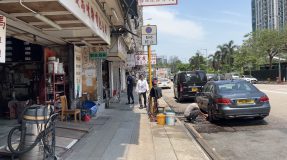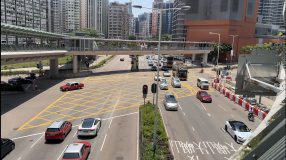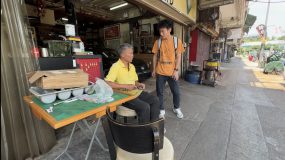Cui Yuxiang 3036218184
YouTube: https://youtu.be/b2StRIw5kL0
Introduction
One-third of the car sales in China in 2022 were electric cars. BMW announced that it will achieve 50% electric vehicles in 2030, and Mercedes-Benz declared that it will achieve its goal of becoming an electric vehicle-only brand by 2030. Therefore, it is predictable that there will be more and more electric cars in the future, and traditional engine cars will disappear.
The rapid rise of electric cars has significantly reduced the number of traditional car repair shops in Hong Kong. For the automotive aftermarket, electric vehicles will affect the spare parts business, accessories business, and customer service. The demand for spare parts will decrease considerably because electric vehicles(Fig.1) have fewer mechanical and moving components than internal combustion engines(Fig.2) . This technological shift has reduced demand for these shops’ specialized skills and services. Furthermore, some of the repair shops also offer automobile repacking services: combustion engines, wheel hubs, empennage, and gearboxes, to name but just a few. However, repacking usually only exists in traditional cars since electric cars’ important components do not need repacking, such as the motor, cell, and battery. Consequently, many repair businesses that need help adapting to the new requirements of electric vehicle maintenance are closing down or liquidating.
Apart from that, the majority of electric cars adopted integrated die-casting technology(Fig.3), which can only be repaired by the company manufacturer since the automotive repair shop does not have the machine for replacing components, so if the electric vehicle suffers from significant damage, it can only be repaired by the manufacturer, but not repair shops. Therefore, traditional car repair shops face unprecedented challenges.
The shift towards environmental sustainability has become increasingly important, with Hong Kong citizens eagerly adopting electric vehicles (EVs) as a cleaner, greener alternative to traditional combustion engines. As more residents choose electric cars, Hong Kong sets a commendable example of how densely populated cities can reduce carbon footprints and become a fully electrified, environmentally friendly urban environment.

Fig.1 Electric vehicle components (Source: http://cv.ce.cn/lbjz/scfx/201711/08/t20171108_26798454.shtml)

Fig.2 Traditional vehicle components (Source: https://www.sohu.com/a/637739161_121490824)

Fig.3 Integrated die-casting (Source: https://www.zhihu.com/question/604294742)
Filming techniques
Wide Shots(Fig.4): Start with wide shots of the exterior of the repair shop to set the scene. These shots provide context and show the automotive repair shop.
Close-ups and Detail Shots(Fig.5): Close-up shots of tools, machinery, and car parts will highlight the craftsmanship and details of the work.
Time-Lapse(Fig.6): Set up a time-lapse to capture the prevalence of electric cars in a city. This shows the large number of electric vehicles in a short amount of time.
Interview(Fig.7): Interviews are a powerful filming technique to illustrate the decline of car repair shops due to the rise of electric vehicles. By featuring personal narratives and expert insights, interviews can provide a compelling perspective for the audience to trust.

Fig.4 Wide Shots (Source: Video Screen Shot)

Fig.5 Close-ups and Detail Shots (Source: Video Screen Shot)

Fig.6 Time-Lapse (Source: Video Screen Shot)

Fig.7 Interview (Source: Video Screen Shot)
Methodology
I finalized the topic of this final assignment because I am a big fan of cars, so I have some insight regarding the market of electric vehicles and vehicle repair shops. At the beginning of the video, I used the Time-Lapse technique to show there are a lot of electric cars in Hong Kong. During the editing process, I accelerated the unnecessary parts and only highlighted the footage that contained electric vehicles so that I could show that there are a lot of electric cars in the city. Besides, the circle can clearly let the audience know which car is electric.
Additionally, I first filmed the repair shop’s appearance from the pedestrians to give the audience a brief impression of what the vehicle repair shop looks like. For example, the size of the shop, the decoration of the shop, how many cars are waiting on the street, etc. Then I filmed inside the shop to show more details, for example, how many employees were inside the shop, how many cars were inside, how many automobile parts were inside the shop, etc.
Moreover, when I shot the automotive repair shop more closely, I used detail shots to show the complexity of the combustion engine or other components; also, many vehicle components are heaped up in the shop. Revealing that traditional vehicles usually need more repair than their electric counterpart.
Lastly, I did a quick interview with an automotive repair shop owner about the trend of automotive repair shops, why the automotive repair shops will disappear, and why the market is diminishing. The first-hand experience and information are essential to our search and conclusion.
Reflection
Using a Video editing APP:
The resolution of the video could be higher (i.e. 2K/4K) since if the phone size is enlarged to computer screen size; the resolution will be decreased.
During Video taking:
Many employees or owners are unwilling to be inside the camera. As a filmmaker or journalist, navigating this delicate balance with respect and understanding becomes imperative. This involves ensuring that their stories are told with integrity by focusing more on voiceovers or using visuals that represent the situation without showing faces. Last, the ethical considerations of documentary filmmaking must be considered.
Bibliography
https://www.statista.com/outlook/mmo/electric-vehicles/china
Mercedes-Benz:
https://www.mercedes-benz.com/en/
BMW electric future:
https://www.bmw.com/en/electric-future.html
https://www.sohu.com/a/654585468_115333
Beggs, S., Cardell, S., & Hausman, J. (1981). Assessing the potential demand for electric cars. Journal of econometrics, 17(1), 1-19.
Munhoz, D., Gregolin, J. A. R., de Faria, L. I. L., & de Andrade, T. F. (2007). Automotive Materials: current status, technology trends and challenges.
Dombrowski, U., & Engel, C. (2014). Impact of electric mobility on the after sales service in the automotive industry. Procedia CIRP, 16, 152-157.
Grosso, M., Raileanu, I. C., Krause, J., Raposo, M. A., Duboz, A., Garus, A., … & Ciuffo, B. (2021). How will vehicle automation and electrification affect the automotive maintenance, repair sector?. Transportation Research Interdisciplinary Perspectives, 12, 100495.
Proff, H., & Kilian, D. (Eds.). (2012). Competitiveness of the EU automotive industry in electric vehicles. Duisburg: University of Duisburg-Essen.
Husain, I., Ozpineci, B., Islam, M. S., Gurpinar, E., Su, G. J., Yu, W., … & Sahu, R. (2021). Electric drive technology trends, challenges, and opportunities for future electric vehicles. Proceedings of the IEEE, 109(6), 1039-1059.
Rabiger, M. (2013). Directing: Film techniques and aesthetics. Routledge.
Ryan, M., & Lenos, M. (2020). An introduction to film analysis: Technique and meaning in narrative film. Bloomsbury Publishing USA.
Comments: